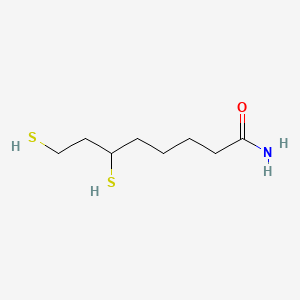| MeSH term | MeSH ID | Detail |
|---|---|---|
| Parkinsonian Disorders | D020734 | 20 associated lipids |
Dihydrolipoamide
Dihydrolipoamide is a lipid of Fatty Acyls (FA) class. Dihydrolipoamide is associated with abnormalities such as Wiskott-Aldrich Syndrome. The involved functions are known as Citric Acid Cycle, Electron Transport, NADH oxidation, Oxidation and Oxidants. Dihydrolipoamide often locates in Mitochondria, Mitochondrial matrix and Chloroplasts. The associated genes with Dihydrolipoamide are Mutant Proteins, Recombinant Proteins, mycothione reductase, Genes, Mitochondrial and alanylproline.
Cross Reference
Introduction
To understand associated biological information of Dihydrolipoamide, we collected biological information of abnormalities, associated pathways, cellular/molecular locations, biological functions, related genes/proteins, lipids and common seen animal/experimental models with organized paragraphs from literatures.
What diseases are associated with Dihydrolipoamide?
Dihydrolipoamide is suspected in and other diseases in descending order of the highest number of associated sentences.
Related references are mostly published in these journals:
| Disease | Cross reference | Weighted score | Related literature |
|---|
Possible diseases from mapped MeSH terms on references
We collected disease MeSH terms mapped to the references associated with Dihydrolipoamide
PubChem Associated disorders and diseases
What pathways are associated with Dihydrolipoamide
There are no associated biomedical information in the current reference collection.
PubChem Biomolecular Interactions and Pathways
Link to PubChem Biomolecular Interactions and PathwaysWhat cellular locations are associated with Dihydrolipoamide?
Visualization in cellular structure
Associated locations are in red color. Not associated locations are in black.
Related references are published most in these journals:
| Location | Cross reference | Weighted score | Related literatures |
|---|
What functions are associated with Dihydrolipoamide?
Related references are published most in these journals:
| Function | Cross reference | Weighted score | Related literatures |
|---|
What lipids are associated with Dihydrolipoamide?
There are no associated biomedical information in the current reference collection.
What genes are associated with Dihydrolipoamide?
Related references are published most in these journals:
| Gene | Cross reference | Weighted score | Related literatures |
|---|
What common seen animal models are associated with Dihydrolipoamide?
There are no associated biomedical information in the current reference collection.
NCBI Entrez Crosslinks
All references with Dihydrolipoamide
Download all related citations| Authors | Title | Published | Journal | PubMed Link |
|---|---|---|---|---|
| Vilei EM et al. | Beta-D-glucoside utilization by Mycoplasma mycoides subsp. mycoides SC: possible involvement in the control of cytotoxicity towards bovine lung cells. | 2007 | BMC Microbiol. | pmid:17439646 |
| Islam MM et al. | A novel branched-chain amino acid metabolon. Protein-protein interactions in a supramolecular complex. | 2007 | J. Biol. Chem. | pmid:17314104 |
| Mochel F et al. | Early energy deficit in Huntington disease: identification of a plasma biomarker traceable during disease progression. | 2007 | PLoS ONE | pmid:17653274 |
| Chiu KP et al. | Pathway aberrations of murine melanoma cells observed in Paired-End diTag transcriptomes. | 2007 | BMC Cancer | pmid:17594473 |
| Deghmane AE et al. | Lipoamide dehydrogenase mediates retention of coronin-1 on BCG vacuoles, leading to arrest in phagosome maturation. | 2007 | J. Cell. Sci. | pmid:17652161 |
| Hussain SN et al. | Modifications of proteins by 4-hydroxy-2-nonenal in the ventilatory muscles of rats. | 2006 | Am. J. Physiol. Lung Cell Mol. Physiol. | pmid:16603597 |
| Roy G and Mugesh G | Bioinorganic chemistry in thyroid gland: effect of antithyroid drugs on peroxidase-catalyzed oxidation and iodination reactions. | 2006 | Bioinorg Chem Appl | pmid:17497002 |
| Mongodin EF et al. | Secrets of soil survival revealed by the genome sequence of Arthrobacter aurescens TC1. | 2006 | PLoS Genet. | pmid:17194220 |
| Mukherjee M et al. | Proteins of the glycine decarboxylase complex in the hydrogenosome of Trichomonas vaginalis. | 2006 | Eukaryotic Cell | pmid:17158739 |
| Kunieda T et al. | Carbohydrate metabolism genes and pathways in insects: insights from the honey bee genome. | 2006 | Insect Mol. Biol. | pmid:17069632 |
| Brown RM et al. | Pyruvate dehydrogenase E3 binding protein (protein X) deficiency. | 2006 | Dev Med Child Neurol | pmid:16904023 |
| Bunik VI et al. | Brain pyruvate and 2-oxoglutarate dehydrogenase complexes are mitochondrial targets of the CoA ester of the Refsum disease marker phytanic acid. | 2006 | FEBS Lett. | pmid:16737698 |
| Lee H et al. | An integrated approach to the prediction of domain-domain interactions. | 2006 | BMC Bioinformatics | pmid:16725050 |
| Smolle M et al. | A new level of architectural complexity in the human pyruvate dehydrogenase complex. | 2006 | J. Biol. Chem. | pmid:16679318 |
| Vasiliou V et al. | Update of the NAD(P)H:quinone oxidoreductase (NQO) gene family. | 2006 | Hum. Genomics | pmid:16595077 |
| Brautigam CA et al. | Structural insight into interactions between dihydrolipoamide dehydrogenase (E3) and E3 binding protein of human pyruvate dehydrogenase complex. | 2006 | Structure | pmid:16442803 |
| Ciszak EM et al. | How dihydrolipoamide dehydrogenase-binding protein binds dihydrolipoamide dehydrogenase in the human pyruvate dehydrogenase complex. | 2006 | J. Biol. Chem. | pmid:16263718 |
| Boucher IW et al. | Structural and biochemical characterization of a mitochondrial peroxiredoxin from Plasmodium falciparum. | 2006 | Mol. Microbiol. | pmid:16879648 |
| Kato M et al. | A synchronized substrate-gating mechanism revealed by cubic-core structure of the bovine branched-chain alpha-ketoacid dehydrogenase complex. | 2006 | EMBO J. | pmid:17124494 |
| Li M et al. | Effect of lpdA gene knockout on the metabolism in Escherichia coli based on enzyme activities, intracellular metabolite concentrations and metabolic flux analysis by 13C-labeling experiments. | 2006 | J. Biotechnol. | pmid:16310273 |
